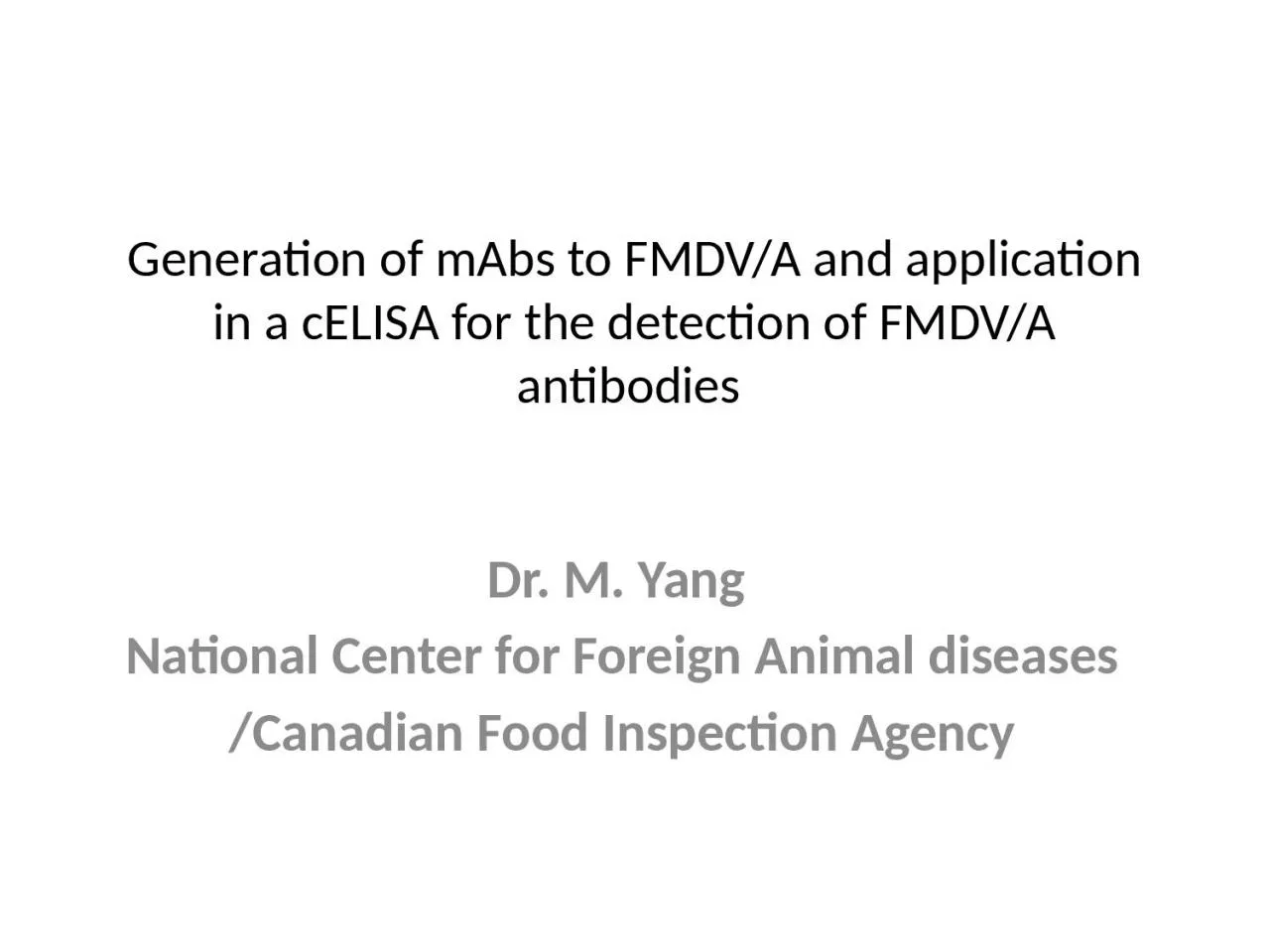

cELISA for the detection of FMDVA antibodies Dr M Yang National Center for Foreign Animal diseases Canadian Food Inspection Agency Introduction Footandmouth disease FMD remains one of the worlds ID: 916338
Download Presentation The PPT/PDF document "Generation of mAbs to FMDV/A and appli..." is the property of its rightful owner. Permission is granted to download and print the materials on this web site for personal, non-commercial use only, and to display it on your personal computer provided you do not modify the materials and that you retain all copyright notices contained in the materials. By downloading content from our website, you accept the terms of this agreement.
Slide1
Generation of mAbs to FMDV/A and application in a cELISA for the detection of FMDV/A antibodies
Dr. M. Yang
National Center for Foreign Animal diseases
/Canadian Food Inspection Agency
Slide2Introduction Foot-and-mouth disease (FMD) remains one of the world’s most
widespread epizootic
and highly
contagious
disease.
FMD
can cause major economic losses
even in previously
FMD free countries
.
Over 100 countries around world are not considered
FMD free
by
the
OIE.
FMD is endemic in many
areas
of Asia, Africa,
and
South America
FMDV
is recognized as
7
serotypes: O, A, C
, Asia
1, SAT 1, SAT 2
and
SAT
3. O and A are the most wide spread.
FMD
is caused by a single-stranded RNA virus belonging
to
the family
Picornaviridae
.
Slide3FMD is difficult to control and eradicate because of
1. rapid virus replication
2.
high mutation rate
3. high
levels of viral
excretion
4. small
doses
required for infection
5. multiple
forms of transmission
(contact, aerosols)
6. wide
geographical
distribution
7. broad
host range
(cattle
, buffaloes, pigs, sheep,
goats
, and
~
70 wildlife
species)
8. ability
to establish carrier
status (not in pigs)
9. antigenic
diversity leading to poor cross
immunity among serotypes
10. relatively
short duration of immunity
(
Longjam
et al., 2011;
Maree et al, 2011)
Slide4FMDV antibody detectionFMDV specific antibody identification is
very useful
for:
(1)
as an indicator of FMDV infection
(2) the
screening of
animals for
the presence of antibodies
before
inter‑territorial movement,
(3)
testing vaccine potency and monitoring the
effectiveness
of
vaccinations
(4)
for epidemiological studies of disease in animal populations
(Have
and
Jensen, 1983)
Slide5Virus neutralization test VNT is routinely used to detect FMDV antibodies
1. VNT is
costly and labour
intensive
2. The
procedure requires live virus,
limiting
the test to
BL3
3. VNT requires 2-3 days to
obtain results.
ELISAs
are
sensitive, specific
,
rapid (hours), easy
to
perform and scale up.
cELISA
is
suitable for the detection of antibodies from different
species.
Slide6ObjectivesTo generate and characterize FMDV/A specific mAb
2.
To develop
a
cELISA
for serological
detection
of
FMDV‑A antibodies
3.
To validate the
cELISA
Advantages using
mAbs
low cross-reactivity; easy
in
standardization;
and less batch to batch variations
Slide7Characterization of the mAbs against FMDV serotype A
Slide8Reactivity of
mAbs
against FMDV/A 46 isolates in DAS ELISA
Slide9VP2
1
In mature virus particle, 60 copies of the four structural proteins VP1-4
associate to form a capsid which surrounds and protects the genome.
3D structure of FMDV
Slide10Localization of FMDV/A antigenic sites in capsid protein
Maree et al, 2011
Slide11mAb resistant mutant selection for conformation epitope identification
1.FMDV/A22 Iraq and purified
mAbs
were incubate
for 30
min
at 37
o
C.
2. The
virus/
mAb mixture and controls were inoculated onto MVPK cells. 3. The flasks were incubated
until 100% CPE observed and culture supernatants were collected. 1-3 steps were repeated 6 times.4. The mutants were purified by plaque purification.
5. The selected mutants were sequenced. Pairwise Sequence Alignment is used to identify mutation regions.
Slide12ELISA results after mutant selection
mAb
#5
mAb
#7
Slide13Identification of neutralization sites of the two mAbs in
capsid protein
Slide14Frequency distribution of the negative sera
in
A/
cELISA
The frequencies of the
PI
generated from these sera were
normal distributed
Calculated diagnostic
specificity
is
99.7
%
Slide15A/
cELISA
3B
cELISA
Detection of
FMDV
antibodies in animals inoculated with
FMDV/A24
100%
seroconversion
at
5 dpi
0% positive at 5 dpi
83%
seroconversion
at 7 dpi
3B
cELISA
is used for surveillance to
monitor
FMDV circulation
(Chen et al., 2011)
Slide16A/cELISA
3B
cELISA
Detection of
FMDV
antibodies in animals inoculated with
FMDV/A22 Iraq
Both were positive at 6 dpi
Both were
seropositive
at
5 dpi
Slide17A/
cELISA
3B
cELISA
Detection of
FMDV
antibodies in
sheep inoculated with FMDV/A Vietnam/13
#19-28 coronary
band
inoculated and #
29-36
contact infected by
Jacquelyn
Horsington
100
%
seroconversion
at
7
dpc
VNT
100% at 9
dpc
38.9%
seroconversion
at 7dpc
100% at 10
dpc
Slide18Detection of
FMDV
antibodies in
vaccinated and challenged-sheep
A/
cELISA
VNT
Sheep were vaccinated
with A22 Iraq
and challenged with
A Vietnam/13 after 4
days vaccination
3B
cELISA
Seroconversion
A/
cELISA
VNT 3B
cELISA
8
dpc
50% 17% 17%
9dpc 100% 33% 33%
Slide19O/
cELISA
A/
cELISA
specificity using sera from sheep vaccinated
with
O1
Manisa
and challenged
with
O/SKR/10
(
Jacquelyn
Horsington
et al.,
2014)
A/
cELISA
Slide20Summary
1. A
panel of FMDV/A specific
mAbs
were
generated. The
binding epitopes of the two
mAb
used in this
A/
cELISA
were well characterized. 2. One of the mAbs’ binding sites is conserved among all the tested isolates of FMDV/A. 3. The FMD A/cELISA that was developed using two
mAbs and BEI inactivated FMDV/A antigen. 4. The A/cELISA exhibited comparable performance to the VNT and 3B
cELISA, but more sensitive than the VNT and 3B cELISA 5. The cELISA is a
simple and rapid test for the detection of FMDV/A-specific Abs.
Slide21Acknowledgements
NCFAD/CFIA
Hilary
Bittner,
Wanhong
Xu
,
Melissa
Goolia
,
Haben
Gabir, Kate Hola, Tim Salo, Dr. Charles NfonAnimal care staffs
Australian Animal Health LaboratoryDr. Jacquelyn Horsington